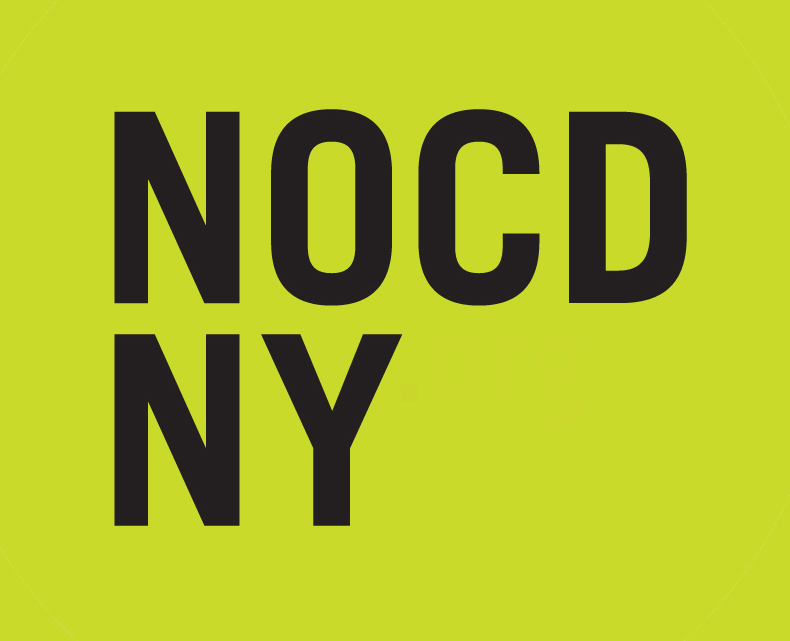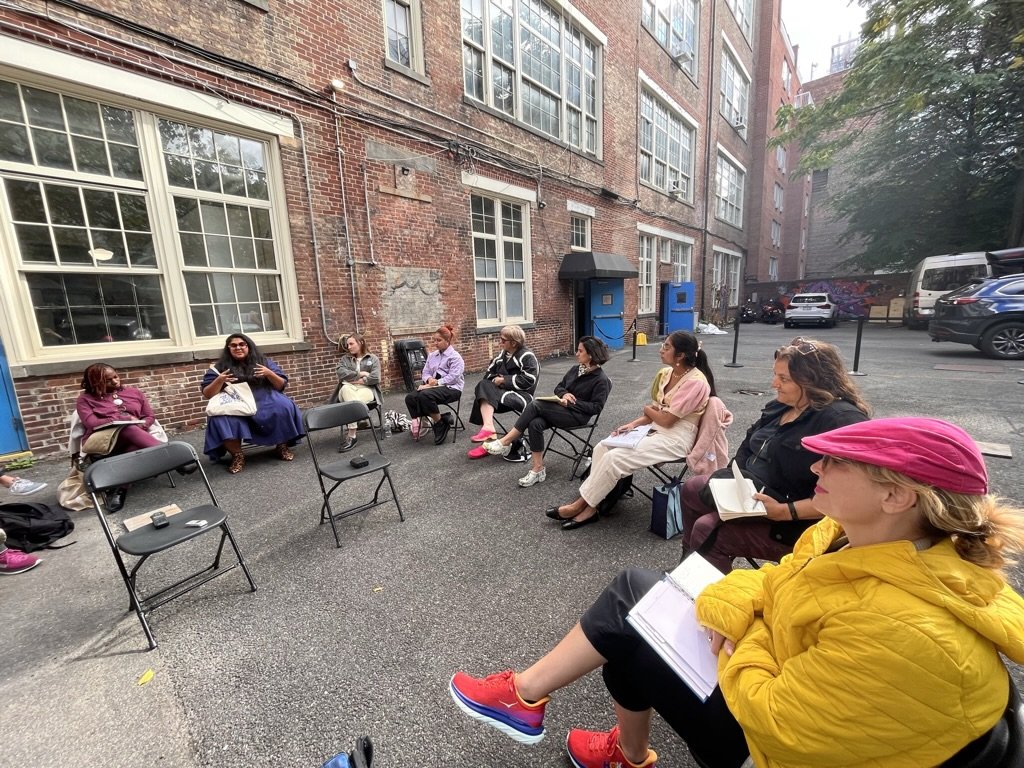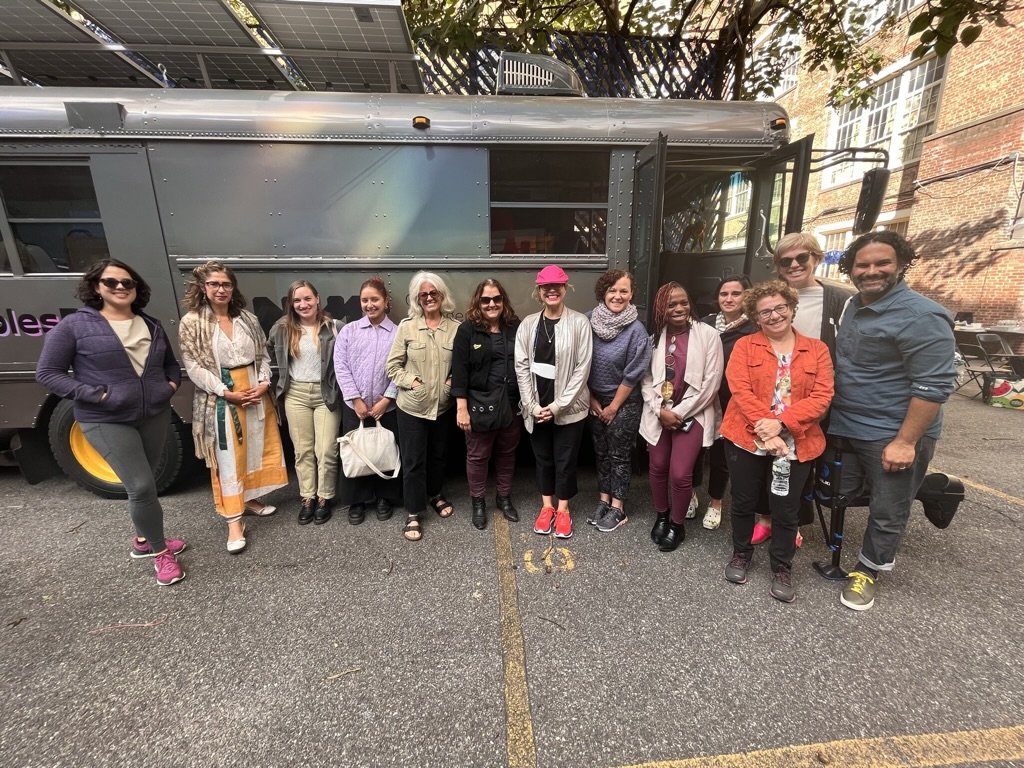Let’s Take This Outside: Arts and Culture in Public Space
La Plaza at The Clemente. photo: Hatuey Ramos-Fermín, c/o NOCD-NY
Let’s Take This Outside
Arts and Culture in Public Space
Essay by Mariana Mogilevich
If you are going to reimagine the future of arts and culture in public space, La Plaza at the Clemente Center is a good place to do it. The parking lot turned performance and gathering space demonstrates the possibility for the radical transformation of overlooked and “underused” outdoor spaces. Stationed there is the People’s Bus, decommissioned from the Department of Corrections, refinished in mirrors and beads with an exterior coat of metallic paint. A vehicle that once transported people to the penal colony at Rikers Island, became, during the pandemic, a community center on wheels. It’s an object lesson in the power of art to bring new uses and meanings to rigid structures, and a living reminder of the streets, parks, and sidewalks that were remade with human activity and creativity born out of some of New York City’s darkest days.
People’s Bus in La Plaza at The Clemente. photo: Hatuey Ramos-Fermín, c/o NOCD-NY
Outside at La Plaza, the group convened this past October afternoon can gather face-to-face, folding chairs spaced in a broad circle, no masks or health and safety concerns. At the same time, it is a brisk afternoon, and the wind makes it hard to hear the softer voices, let alone pick them up on the audio recorder. The air gets chilly once the sun begins to disappear behind Norfolk Street. Performers from Teatro SEA, a resident organization of The Clemente, assemble for a procession with Little Amal, the twelve-foot, ten-year-old Syrian girl who is halfway through her two-week tour of New York City. Lots of things can happen simultaneously out here, and that can be exciting but also loud and distracting. So it goes when we take things outside.
The conversation in La Plaza is the first meeting convened in person by NOCD-NY since the start of the pandemic, a “family reunion,” says co-founder and director Caron Atlas. Many people are coming together after much time apart and over Zoom, and there is a lot to process: death, grief, safety, business as usual, and radical possibility.
Much has been asked of New York City’s public spaces over the last two years: to provide space to distance, and space to come together. Also space to rehearse, to perform, to play, to consume, to relax, to organize, to learn, to live. So much has been asked, too, of the city’s arts and culture organizations and the people who run them. Stop operations, resume operations, support communities in need, move things outside, do your thing, try new things, spend money, find money, keep going. We are here to talk about what we’ve seen in our neighborhoods, in public programs, protests, and celebrations: the unreal and the hyperreal. We’ll share these stories in the service of authoring a new “science fiction,” as artist Hatuey Ramos-Fermín proposes, channeling adrienne maree brown, learning, in turn, from Octavia Butler. But we can not start envisioning the future without accounting for the past, because that too has been almost unimaginable. There are the horrors that we might not have dreamed possible, but the pandemic made extraordinary things possible, too, eliminating, for a time, structures and barriers that previously seemed immovable.
In the early months of the pandemic in New York City, we needed more space. We had to take things outside. Many of those with resources to do so got out of town. Everyone else needed to get out of the house and out of close quarters, looking for space to be, to breathe, and also to carry on. Reflecting on new and liberatory engagements with public space, what we experienced and what we’d want to hold on to, artist Elizabeth Hamby pointed to the scenes of “life lived outside,” the birthday celebrations and other milestones that moved to local parks. Tamara Greenfield, NOCD-NY co-founder and board member, similarly recalled the intensification of hyperlocal experience, getting to know her neighborhood in a new way by seeing all its microcultures—the dancing grannies, the ballet classes, the summer camps, the fitness training—out in the open. Hatuey, too, noted the activation of his community after the murder of George Floyd, and the simple, spiritual power of the drummers who gathered in the park. With so much broken apart, new ways of using familiar spaces were cracked open, too.
Community Iftar at Avenue C Plaza in Kensington. photo: The Rathkopfs
Public spaces provided a frame for people to come together and a bridge across differences. When a community iftar could resume in person at Avenue C Plaza in Kensington, Caron Atlas described the powerful, palpable, connection between people at the interfaith gathering. Jana La Sorte, Administrator of Historic Harlem Parks/NYC Parks, was still buzzing from the live simulcast of the premiere of Fire Shut Up in My Bones in the Richard Rodgers Amphitheater at Marcus Garvey Park. At the presentation of the Metropolitan Opera’s first-ever performance of an opera by an African American composer to the mecca of Black culture, “people were crying, just overjoyed to see themselves.” Public spaces provided transformative experiences not just for audiences, but for the performers who turned to the outdoors out of necessity. When performance artists had no way to share their work, artist Yanira Castro described creating public scores outside the theater, and dancer Imani Vieira recalled participating in company rehearsals in Jackie Robinson Park as “an experience unto itself.” Dakota Scott, a writer and Managing Director of FABnyc, voiced the understated truth that “we all need a little more space” in New York City. She and Imani Vieira, artist and FABnyc's Senior Program Manager, discovered some of that space in the Lower East Side where two Open Streets, closed to car traffic, made room not just for FABnyc to continue its arts programming, but for passersby to become an audience and neighbors to become performers.
We also needed space to grieve. Ofrendas for the Day of the Dead produced by Casa Cultural with ArtBuilt at the Brooklyn Army Terminal and by Manhatitlan Mexican Folkloric Dance Club in the plazas under the 7 line in Queens provided shared environments in which to reflect on and come to terms with a year of unfathomable loss. Karla Pérez of Manhatitlan moved the celebration out of its traditional place in a church to somewhere “where we could all be together.” Catherine Green-Johnson, Director of Programs at The Laundromat Project, brought people who lost loved ones to Covid together at the Brownsville Heritage House to create a memorial quilt. After weaving and working through grief together in real time and place, community members participated in healing circles at a Juneteenth event in Prospect Park. It was a moment “that needed to happen in public space.”
If local and familiar parks, streets, and plazas welcomed new uses, a moment of intensified need also spurred the reimagination of improbable spaces, where long term injustices might make way for new sites to come together in joy. Libertad Guerra, The Clemente Soto Velez Cultural & Educational Center's Executive Director, described how South Bronx Unite and the Mott Haven/Port Morris Community Land Stewards brought a resident-initiated cultural festival, including a visiting Uzbeki symphonic orchestra, for a City of Water celebration on a plot of land “where you would least expect it”: a South Bronx waterfront with a waste transfer station and no sanctioned public access, whose neighbors had long been claiming and activating the space to suit their needs and desires.
Lower East Side Community Culture Day on the Avenue B Open Street. photo: c/o of FABnyc
But who gets to claim such spaces? When we take things outside, they are harder to manage. In comparison to the indoor arts venue, working on the street has required “a process of letting go of control,” says Dakota. On Open Streets, FABnyc has been practicing “not being too precious”: being intentional in establishing consistency, but prioritizing local residents and artists and letting it be what people want. Libertad advocates for sometimes letting go of curatorial expertise in favor of a “farmers market” or “community garden” model, where cultural programs are reliably found in a place, but people get to pick and choose what they want to engage with. She argues for the “magic” in intentionally keeping some spaces under the radar and unofficial, where neighbors can produce or discover happenings by and for themselves without a big marketing apparatus. But many in the circle are quick to point out that gatekeepers are agents of both exclusion and inclusion. They can also actively work to make sure more groups feel comfortable where one demographic might maintain a de facto monopoly. It has taken funding and a proactive focus to help immigrant communities feel welcome at the Avenue C Plaza, while a powerful African American legacy at Marcus Garvey Park means that longtime Latino neighbors and white residents can be seen as interlopers. Can it be their park, too? “We’re each caught sometimes, it seems,” Jana analyzes, “in a white corporate model of claiming something is ours,” but Covid also created an opening to transcend it.
Tensions at Marcus Garvey Park—and elsewhere, of course—have extended to negotiating the presence of people who are unhoused, who struggle with mental health, or engage in public drug use. When we take things outside, things also get serious. The difficult question of safety can not be ignored. Often people feel unsafe about public space, Elizabeth notes, because there’s not enough adequate private space to meet everyone’s needs. The lovely and organic, Tamara says, and the difficult and challenging, are all made visible in public space. “I don’t know how to talk about safety,” says Pia Kishore Agrawal, Executive Director of Staten Island Arts, or how to ensure it for performers and audiences of color in spaces where they have not always been visible or welcome. There are things, she says, that she has felt less comfortable presenting in recent years. As always, public spaces reflect and refract social order and fissures, and no one has the resources to perform the enormous acts of compensation that the state of this city requires. When the domestic realm is so impoverished, and we are deprived of housing, health care, mental health support, food, money, security, it's not going to be found outside
So what support is needed to build capacity for civic engagement in place? Things become more visible when we take them outside, but that doesn’t necessarily apply to resources. Could there be easier collaboration with city agencies? Information about spatial resources NYC Parks can provide, Jana points out, is not well known to the cultural community or the public. Libertad would like to find more transparency in cultural support that cuts across agencies, not just coming from one or another. Community-based organizations can act as a bridge between government funding bureaucracies and community led initiatives. But people don’t want to participate in grand schemes and have to contend with government infrastructure, Catherine says. Better to find ways to just get the money in the hands of people already doing things in their communities, as The Laundromat Project is doing through a microgrant program. People doing things in their communities are also a workforce, Elizabeth suggests. They keep spaces alive. Could the City levy a one percent tax for a community stewardship fund, asks Jana? Structures to support stewards might also address longevity. The cultural activation of public space is work that needs to unfold and develop on its own time, a logic that in no way aligns with cycles of funding and support, Esther Robinson, Co-Executive Director of ArtBuilt, laments. It is an act of long-term vision and requires “absolute tenacity of spirit,” says independent curator and cultural organizer Raquel de Anda. But who will carry forward the imagination of a potent moment once the sense of urgency, one hopes, has become a distant memory?
As the perceived “threat” of Covid, too, passes, the urgency of this moment is fading. How to capture lessons and gains of the last two years, and protect and nurture the public space practices that have provided lifelines and new directions across city neighborhoods? What is the dream?
Everyone’s dream is different, but a collective architecture comes into focus fast. This dream public space is one that offers an accessible invitation, where everyone feels welcomed and can show up and connect, have conversations, and debate, or just be quiet and at peace. It is a place where there are resources, information, and education, both about the space itself and the world at large. In short, it’s a library, but it’s outside, with tons of green, free healthy food, a place to hang your hammock, and maybe some animals. Arts and culture in publicly funded, democratic institutions that are locally stewarded and equitably distributed: this is not hard to imagine. The animals could pose a challenge, but after everything we’ve been through and everything we’ve learned, the rest is not too much to ask.
Mariana Mogilevich is editor in chief of Urban Omnibus, The Architectural League of New York's publication dedicated to observing, understanding, and shaping the city, and the author of The Invention of Public Space: Designing for Inclusion in Lindsay's New York.
This gathering was part of Reimagining New York City, a citywide series of visioning sessions and exchanges to incorporate the wisdom, imagination, and creative practices of community cultural organizations, artists, and neighborhood residents in decision making and transformative change.




